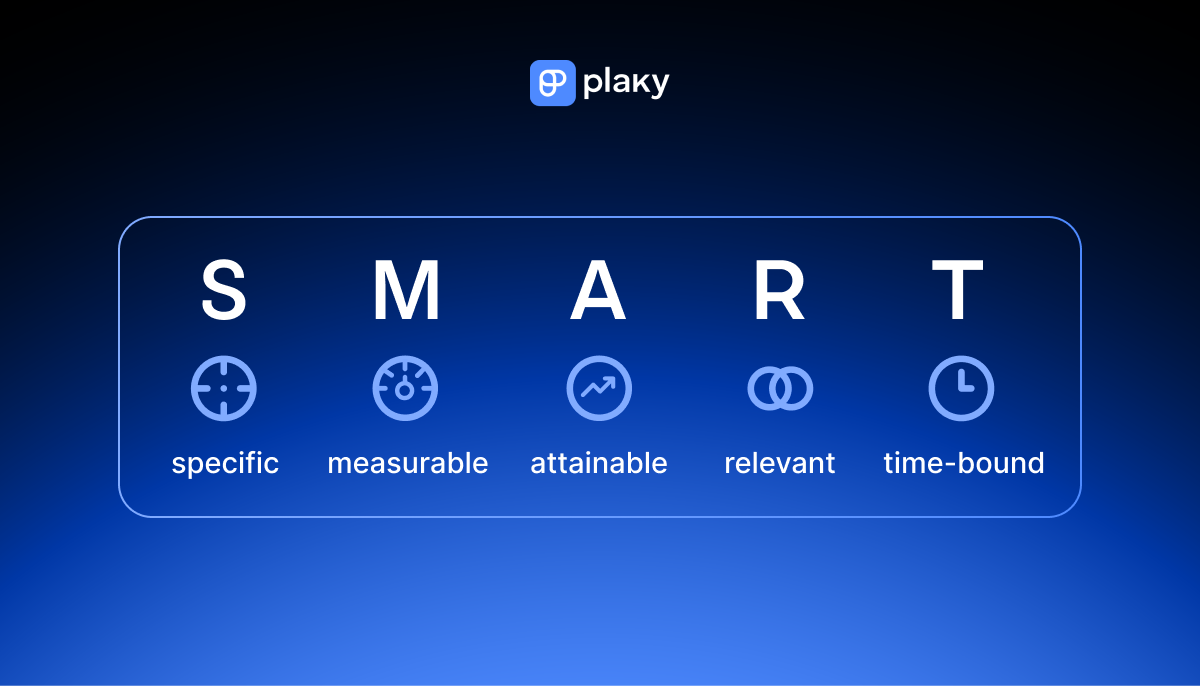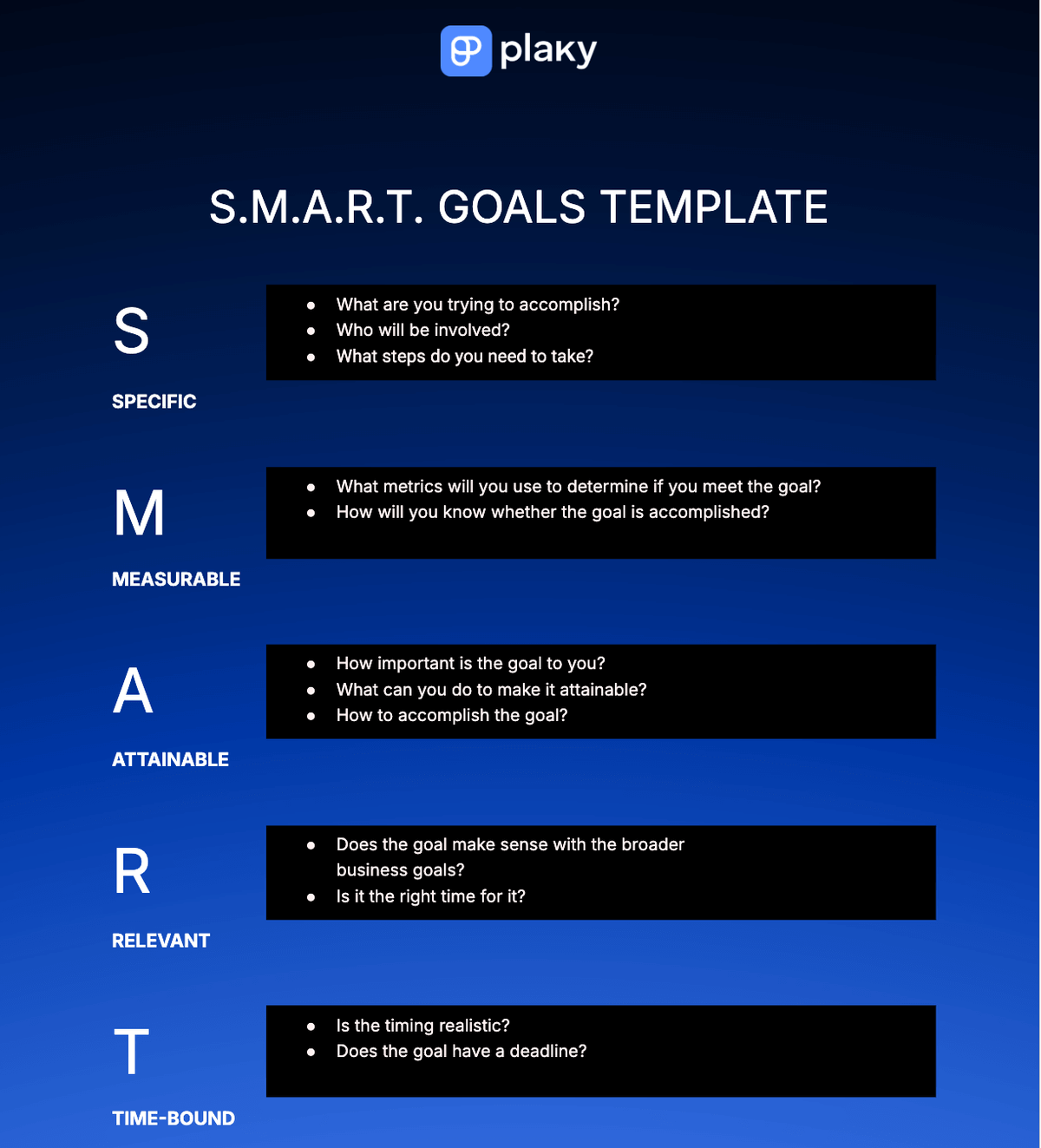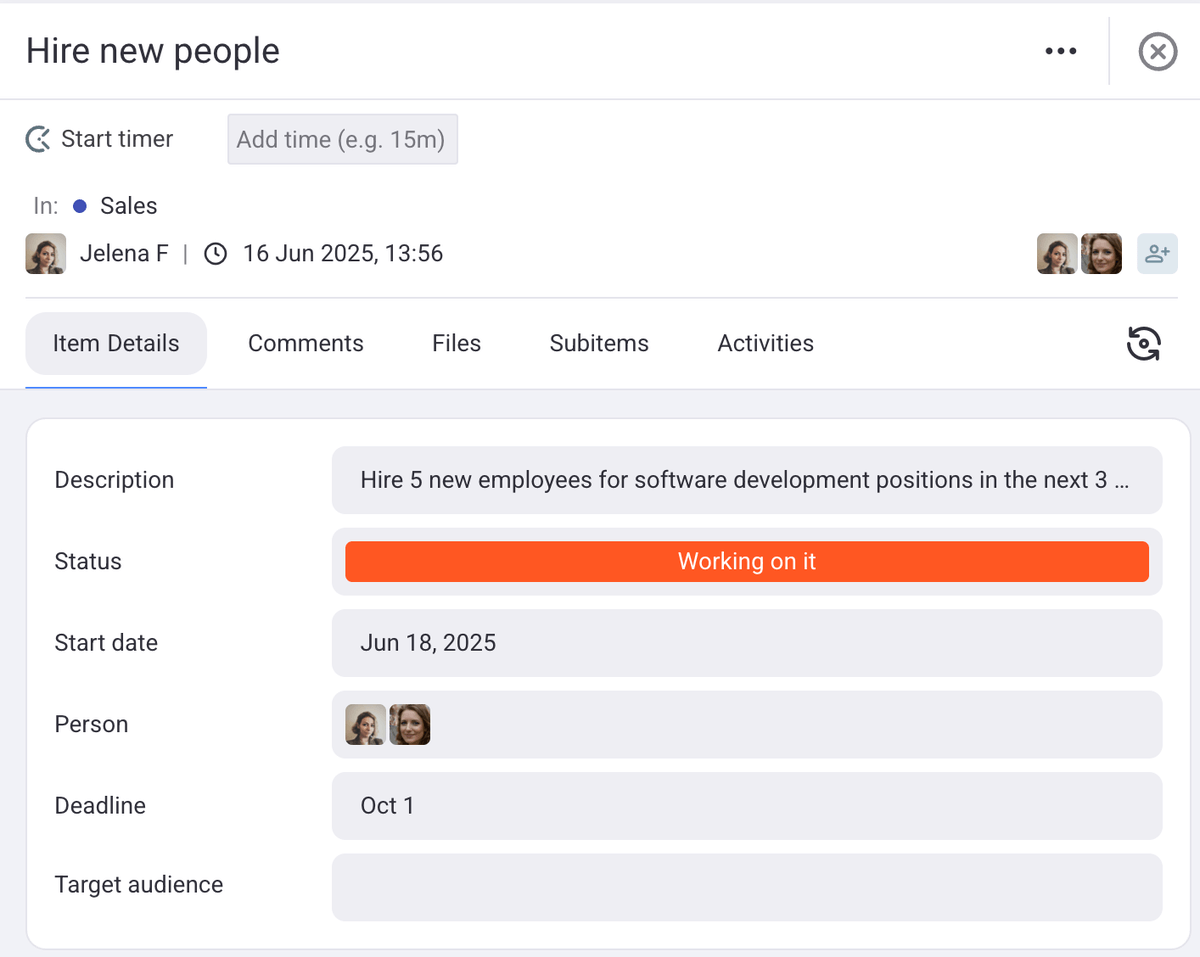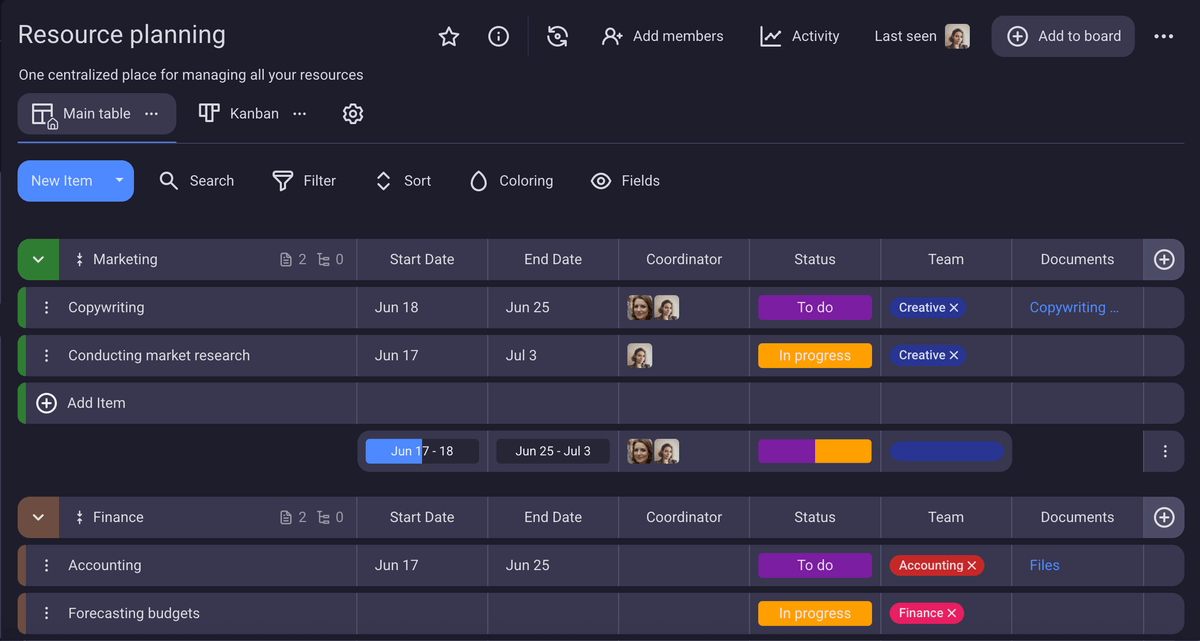Think of the last time you accomplished a goal you’d set for yourself.
Now think of the last time you failed to do so.
What is the mystery behind these attempts — one successful and the other a failure?
The answer probably lies in the goal-setting process itself — or rather a lack thereof.
The good news is that you can change the way you set your goals and make all of them a blazing success. The secret lies in the S.M.A.R.T. goals criteria.
Let’s find out what exactly S.M.A.R.T. in project management means and how to set S.M.A.R.T. goals so that you never have to deal with botched plans again.

In this article:
What are S.M.A.R.T. goals in project management?
In project management, S.M.A.R.T. goals are goals that are:
- Specific — Create clear and well-defined goals.
- Measurable — Define them so that you can measure them.
- Attainable — Ensure people working on these goals can achieve them within a previously specified time frame.
- Relevant — Make sure your goals are relevant for completing your project.
- Time-bound — Don’t forget to determine a target date.

The acronym S.M.A.R.T. dates back to 1981 when George T. Doran published a paper titled “There’s a S.M.A.R.T. Way to Write Management’s Goals and Objectives” in the November issue of Management Review.
According to Doran, the acronym doesn’t mean every written goal will meet all 5 criteria. However, the closer it gets to it, the smarter the goal will be.
Truth be told, S.M.A.R.T. goals do take a little more effort to create, but they are worth it, especially when you consider that a staggering 92% of people never achieve their goals.
Science says it’s due to a lack of reasonable, achievable plans. Yet, having S.M.A.R.T. goals increases your likelihood of succeeding, as you are more precise about:
- What you want to achieve,
- How you will achieve it,
- What resources you need, and
- Other details that are specific to your goal.
💡 Plaky Pro Tip
How are S.M.A.R.T. goals different from stretch goals, and which ones should you pursue? Find out more about stretch goals below:
S.M.A.R.T. goals vs S.M.A.R.T. objectives
Although sometimes used interchangeably, project goals and objectives are not the same thing.
A project goal determines what you need to accomplish, while project objectives picture how you will achieve the goal.
To clarify this, here’s a table with the key differences between S.M.A.R.T. goals and S.M.A.R.T. objectives.
| S.M.A.R.T. goals | S.M.A.R.T. objectives |
|---|---|
| Long-term | Short-term |
| Primary goal | Smaller actions to meet the goal |
| A joint effort of the entire team | Split into simpler tasks for smaller groups of people |
| Based on a general business strategy | More tactical and can be slightly altered based on changing circumstances |
How to set S.M.A.R.T. goals in project management
It’s time to learn how to make your goals S.M.A.R.T. in project management. Here’s a hint — all you need to do is pose the right questions.

S stands for Specific
For a S.M.A.R.T. goal to be specific, it should answer the following questions:
- What are you trying to accomplish?
- Who will be involved?
- What steps do you need to take?
Simply put, a specific goal targets a particular area for improvement.
Let’s see how that looks in practice. In the table below, we’ll give you an example of a vague, non-specific goal, and another one of a specific goal:
| Non-specific goal | Specific goal |
|---|---|
| I want to increase revenue. | I want to increase monthly recurring revenue by 5% from the current baseline of $50,000 to $52,500 by the end of Q3 of 2025, by acquiring 10 new high-value clients. |
So, in the second example, we are more precise about what we want to accomplish. We have:
- Specified the type of revenue we want to increase (monthly recurring revenue) and the current baseline ($50,000),
- Given the time frame (by the end of Q3 of 2025) and
- Explained how we could accomplish this (by acquiring 10 new clients).
M stands for Measurable
Another criterion your goals need to fulfill to be S.M.A.R.T. is that you should be able to measure them. Again, we have a couple of questions that will help you achieve that:
- What metrics will you use to determine whether you meet the goal?
- How will you know whether the goal is accomplished?
Some examples of metrics may be:
- The number of tasks completed per week,
- Average hours spent on each task,
- The number of people working on a specific task, or
- Anything else relevant to your goal.
Long story short, you should summarize what proof will confirm that you have made progress or reached your goal.
Let’s look at some examples in the table below — one of a goal that’s not measurable and one that is.
| Non-measurable goal | Measurable goal |
|---|---|
| We want our company to make more money. | We want our company to increase revenue by 22% in comparison to the previous year. |
The metric used in the second example is percentage, which allows us to easily measure the revenue increase in relation to the previous year.
A stands for Attainable
When setting your project goals, make sure they are realistic and achievable.
To begin with, determine whether you have the resources and capacities to achieve the goal. Getting answers to the following questions may help:
- How important is the goal to you?
- What can you do to make it attainable?
- How can you accomplish the goal?
- Do you have the necessary tools and skills?
Let’s look at examples of both unrealistic and achievable goals:
| Unattainable goal | Attainable goal |
|---|---|
| We want our company to improve the previous year’s performance by 500%. | We want our company to improve the previous year’s performance with a 20% increase through new customers. |
Unless you’ve got an enormous increase in your budget and enough people to work on the first goal, the chances you will achieve a 500% improvement are extremely low.
On the other hand, “improving the previous year’s performance with a 20% increase through new customers” is attainable — i.e., more likely to happen.

R stands for Relevant
A goal must be aligned with corporate priorities to be marked as relevant. In other words, it should correspond to the broader company goals.
When deciding on what is relevant to your business, getting the answers to the following questions may help:
- Does the goal align with the broader business goals?
- Is it the right time for this goal?
Let’s consider some examples of irrelevant and relevant goals.
| Irrelevant goal | Relevant goal |
|---|---|
| A design agency wants to improve their website ranking by getting backlinks from other websites. | A design agency wants to improve their website ranking by getting backlinks from relevant websites (i.e., design blogs, software and tool providers, design schools and universities). |
To sum up, to be relevant, a goal must hold specific significance within the project you are currently performing or your business as an entirety.
T stands for Time-bound
Finally, remember that time-bound goals are achievable in a given time frame.
To make your goals time-bound, you should answer these questions:
- Is the timing realistic?
- Does the goal have a deadline?
S.M.A.R.T. goals require a target date, so you should specify the date by which you want to achieve your goal.
Again, here’s an example of a goal that’s not time-bound and one that is.
| Goal with an unspecified time frame | A time-bound goal |
|---|---|
| Finish the redesign of the company’s official website. | Finish the redesign of the company’s official website and launch it to the public by October 23, 2025. |
By introducing the deadline, you now have a time-bound goal.
S.M.A.R.T. goals template
Feeling overwhelmed with information about setting S.M.A.R.T. goals? Need some extra assistance?
Don’t worry — here’s a template you can use to save time and set clear and effective S.M.A.R.T. goals.

Get our S.M.A.R.T. goals template
Examples of S.M.A.R.T. goals in project management
Now that you know what S.M.A.R.T. in project management stands for and how to create S.M.A.R.T. goals, we’ll give you examples of both weak and S.M.A.R.T. goals in:
- HR,
- Software development,
- Marketing,
- Sales, and
- General project management.
HR: Recruit new people for software development
HR goals are best achieved through smart HR project management. Let’s take a look at examples of setting goals in HR.
Weak goal:
Hire new employees for software development positions.
S.M.A.R.T. goal:
Hire 5 new employees for software development positions in the next 3 months so that they can work on new product development. Set up job ads on the company’s website, relevant job search websites, and LinkedIn. Two HR generalists will work on the selection process. The selection process should end by October 1.

This goal is S.M.A.R.T. because it is:
- Specific: You want to hire 5 new employees for software development positions.
- Measurable: It is easy to measure, as you specify that you plan to hire 5 new employees in the next 3 months.
- Attainable: Hiring 5 people in 3 months is a realistic goal and can be accomplished, as 2 HR generalists will work on this task.
- Relevant: This goal is relevant to your company, as you need developers to work on your new product.
- Time-bound: The selection process will end by October 1.
💡 Plaky Pro Tip
Need a little more help with your HR daily activities? Try out our ready-made HR project templates — from recruitment and employee onboarding to various HR requests:
Software development: Add a new feature to the application
If you run software development projects, adding new features to your application is something you do every now and then. So, let’s set what both a weak and a S.M.A.R.T. goal look like in this context.
Weak goal:
Add a video call feature to the business messaging app.
S.M.A.R.T. goal:
Add a video call feature to the business chat app within the next month. A team of 5 people will work on it, and the feature will be released on July 25, 2025.
This goal is S.M.A.R.T. because it is:
- Specific: You want to add the video call feature.
- Measurable: You want to release the feature within the next month.
- Attainable: 5 developers will work on this task, which is enough workforce to make this goal attainable.
- Relevant: A new feature will add value to the existing application.
- Time-bound: The feature will be released on July 25, 2025.
Setting your S.M.A.R.T. goals can be an integral part of your software development plan. It’ll help your team focus and don’t lose sight of how their work aligns with company goals.
💡 Plaky Pro Tip
Try out ready-made software development project templates:
Marketing: Increase brand awareness
Managing a marketing team comes with its own set of challenges. However, setting goals for your marketing projects doesn’t have to be an issue if you study our examples.
Weak goal:
Increase brand awareness by the end of the year.
S.M.A.R.T. goal:
Increase brand awareness by 25% by December 22. Share at least 2 posts per day per social media account and launch a paid Google Ads campaign. Participate in 2 business-related conferences. The social media, PR, SEO, and paid ads teams will be responsible for this initiative. The metrics can be website traffic growth, the increase in social media post reach, and the number of mentions on social media and in the news outlets.
This goal is:
- Specific: You have a clear goal — to increase brand awareness by 25%.
- Measurable: It can be measured by monitoring the reach of social media posts, mentions on social media and in news outlets, and website traffic growth.
- Attainable: You’ll have enough staff to achieve the goal — your social media, PR, SEO, and paid ads teams will help you.
- Relevant: Brand awareness campaigns can help establish your company as a leader in its industry.
- Time-bound: You want to reach your goal by December 22.
💡 Plaky Pro Tip
Need a little help with your marketing project management? You’ll find all the templates you need in our templates library, including strategy plan template, content calendar template, and many more.
Sales: Find more premium plan users
If you’re a sales manager looking to increase your company’s overall sales, you’ll need some carefully crafted objectives. Here are some examples of setting goals to elevate your sales projects.
Weak goal:
Get more premium plan users.
S.M.A.R.T. goal:
Get new paid plan users by converting 25% of free trial users to a paid plan in the next 6 months. The sales team will reach out to people using our free trial and book a demo presentation.
Again, this goal is S.M.A.R.T. because it is:
- Specific: You want to get new paid users by converting 25% of free trial users to a paid plan in the next 6 months.
- Measurable: Your plan is to convert 25% of free trial users to a paid plan.
- Attainable: Since there’s already a large number of people using the free trial, it’s realistic that some of them will want to convert to a paid plan.
- Relevant: Paid plan users generate more income for the company.
- Time-bound: You want to get more paid users in the next 6 months.

💡 Plaky Pro Tip
Sales doesn’t have to be overwhelming — with the right templates, that is. Try our sales and CMR project templates:
General project management: Decrease team overtime
A project manager’s job can be challenging, but setting S.M.A.R.T. goals should ease the burden. Your team will know what exactly they need to do to achieve the best results without working overtime.
Weak goal:
Reduce team overtime in the marketing department.
S.M.A.R.T. goal:
Reduce team overtime in the marketing department by 25% by the end of August 2025 by optimizing resource allocation and task assignments, making sure team members are not overworked but are still fully utilized.
This goal is S.M.A.R.T. because it is:
- Specific: You want to reduce team overtime by 25% by the end of August 2025.
- Measurable: Marketing team’s overtime will decrease by 25%.
- Attainable: After identifying bottlenecks and distributing work evenly, we can expect that the marketing team should be able to accomplish their goals without working extra hours.
- Relevant: Your team will be more engaged and satisfied by not having to work overtime.
- Time-bound: By the end of August 2025, your team will not be working overtime so much.

💡 Plaky Pro Tip
In the mood to try out a new PM tool? With our single project template, you’ll be up and running in 15 minutes:
Organize your S.M.A.R.T. goals with Plaky
Setting S.M.A.R.T. goals for your project is just the beginning of the journey. The next step is to monitor their progress and make sure you don’t miss anything critical.
Luckily, there are project management tools that help you with all that — like Plaky.
Highly customizable and free for an unlimited number of users and projects, Plaky is a perfect tool for tracking your S.M.A.R.T. goals that allows you to:
- Break down your workflow into manageable tasks — Use items and subitems with clear descriptions, due dates, and assignees so that nothing gets overlooked.
- Share all the S.M.A.R.T. goal-related files within the item itself — You’ll never have to waste your time searching for data you need.
- Track your goal’s progress — Mark your tasks as To Do, In Progress, or Done to get a clear picture of how everything is going at any time.
- Assign different roles and permissions — Control the access to and the security of your projects. Provide your stakeholders with access to relevant boards so that they can understand the goal’s relevance.
- Track time — Thanks to Plaky’s Clockify integration, you can easily get measurable data for all your efficiency-related goals.
- Customize fields — Structure information you need in a way that suits you and your team, e.g., add fields with specific details relevant to your goals (target audience, various metrics, and more).

Enjoy smart goal-tracking with Plaky
Bonus? Plaky is also super-affordable. Even though its free plan is excellent — thanks to unlimited spaces, boards, items, and views — you won’t break the bank if you opt for one of its paid plans.

Need a smart solution for keeping your S.M.A.R.T. goals in order? Sign up for Plaky today!

